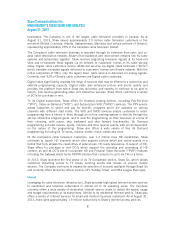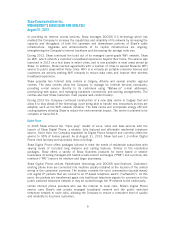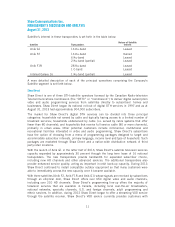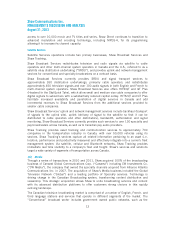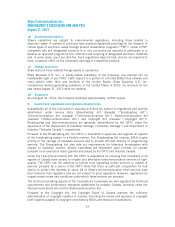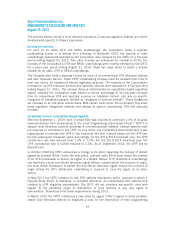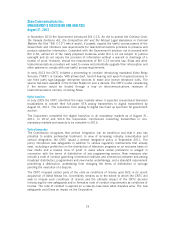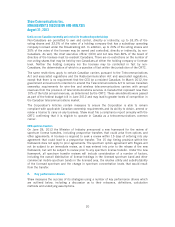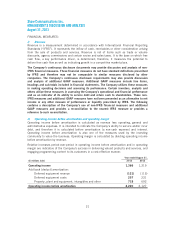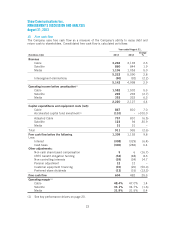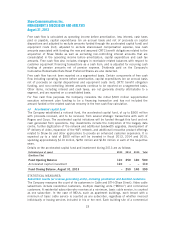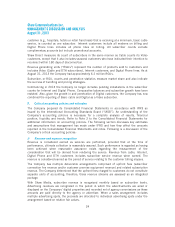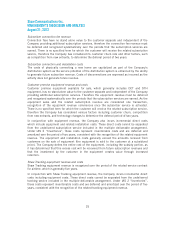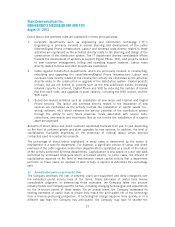Shaw 2013 Annual Report Download - page 22
Download and view the complete annual report
Please find page 22 of the 2013 Shaw annual report below. You can navigate through the pages in the report by either clicking on the pages listed below, or by using the keyword search tool below to find specific information within the annual report.S
haw
C
ommunications Inc
.
MANA
G
EMENT’
S
DI
SCUSS
I
O
N AND ANALY
S
I
S
August
31
,
2013
U
nder the Telecommun
i
cat
i
ons Act, the
C
or
p
orat
i
on ma
y
construct
f
ac
i
l
i
t
i
es
i
n roadwa
y
san
d
o
ther public places with the consent of the municipality. In 2011, the CRTC initiated a process
whereby a working group of industry and municipal representatives developed a non-bindin
g
m
odel mun
i
c
ip
al access a
g
reement. In November
2013
, the
C
RT
C
a
pp
roved the consensu
s
recommendations of the working group for the model agreement and determined that certai
n
n
on-consensus items, includin
g
indemnification, fees, and relocation costs, are to be
n
e
g
ot
i
ated between a carr
i
er and a mun
i
c
ip
al
i
t
y.
New media and Internet
I
n June
2009
the
C
RT
Ci
ssued
i
ts dec
i
s
i
on on
“
new med
i
a” b
y
extend
i
n
gi
ts exem
p
t
i
on o
f
the
provision of digital media broadcasting undertakings for another five years. It also decide
d
against imposing any regulatory measures, including financial contribution requirements o
n
IS
Ps, to su
pp
ort
C
anad
i
an new med
i
a content
.
S
haw
i
s mandated b
y
the
C
RT
C
to
p
rov
i
de Th
i
rd Part
y
Internet Access
(“
TPIA”
)
serv
i
ce, wh
i
ch
enables
i
ndependent I
S
Ps to prov
i
de Internet serv
i
ces at prem
i
ses served by
S
haw’s network. I
n
2011, the CRTC reviewed the billing model for TPIA services, TPIA rates and whether usag
e
based b
i
ll
i
n
g
ma
y
be a
pp
l
i
ed to TPIA serv
i
ces. In the dec
i
s
i
on that
f
ollowed
i
ts rev
i
ew
(
th
e
“
Wholesale Internet Access Dec
i
s
i
on”
)
, the
C
RT
C
approved two b
i
ll
i
ng models, a
f
lat-rate model
in which the TPIA rate includes access and usage and a capacity-based model in which access
and ca
p
ac
i
t
y
usa
g
e are b
i
lled se
p
aratel
y
.
S
haw
i
s currentl
y
a
pp
roved to
p
rov
i
de TPIA serv
i
c
e
u
nder the
f
lat-rate model although
S
haw may elect to move to a capac
i
ty-based model
i
nth
e
f
uture. The CRTC is currently reviewing the regulatory regime for several wholesale competito
r
serv
i
ces,
i
nclud
i
n
g
TPIA, throu
g
ha
p
ubl
i
c consultat
i
on that launched
i
n
O
ctober
2013.
I
n
S
e
p
tember
2013
, a consort
i
um o
fi
nde
p
endent I
S
Ps
fi
led an a
pp
l
i
cat
i
on w
i
th the
C
RT
C
request
i
ng changes to the TPIA serv
i
ce. I
f
the
C
RT
C
mandates the changes to TPIA as
requested in the application, this would require Shaw to dedicate additional resources t
o
address s
p
ec
ifi
c serv
i
ce order
p
rocess
i
n
g
,ITs
y
stem and b
i
ll
i
n
g
s
y
stem chan
g
es
.
I
n late
2010
Parl
i
ament
p
assed ant
i
-s
p
am le
gi
slat
i
on, wh
i
ch has not
y
et come
i
nto
f
orce
.
C
anada’s ant
i
-spam leg
i
slat
i
on
(“C
A
S
L”
)
sets out a comprehens
i
ve regulatory reg
i
me regard
i
n
g
o
n-line commerce, including requirements to obtain consent prior to sending commercial
electron
i
c messa
g
es and
i
nstall
i
n
g
com
p
uter
p
ro
g
rams.
C
om
p
l
i
ance w
i
th
C
A
S
Lw
i
ll re
q
u
i
re
Shaw to review and update its current practices with respect to marketing and other
communications with customers.
Shaw and other telecommunications providers had expected that they would need to review an
d
p
otent
i
all
y
u
pg
rade the
i
r
i
nterce
p
t
i
on and other s
y
stems to com
p
l
y
w
i
th ant
i
c
ip
ated law
f
ul
access requirements. In February 2013, the Government announced that it would not be
proceeding with its planned lawful access legislation, Bill C-30
,
An Act to enact th
e
I
nvest
ig
at
i
n
g
and Prevent
i
n
gC
r
i
m
i
nal Electron
i
c
C
ommun
i
cat
i
ons Ac
t
(
the
“
B
i
ll”
)
and relate
d
plan to amend the
C
rimin
a
l
Code
a
n
dot
h
e
rA
cts
.Th
eGo
v
e
rnm
e
n
t
in
d
i
cated t
h
at
i
ts dec
i
s
i
on
n
ot to proceed was in response to the expressed concerns of Canadians regarding the Bill. Th
e
le
gi
slat
i
on would have re
q
u
i
red telecommun
i
cat
i
ons serv
i
ce
p
rov
i
ders to
p
rov
i
de subscr
i
ber
information without a warrant and for ISPs to establish and maintain capabilities to facilitat
e
t
he lawful interception of information transmitted by telecommunications and to provid
e
i
n
f
ormat
i
on about subscr
i
bers to law en
f
orcement a
g
enc
i
es.
18


